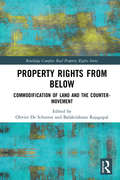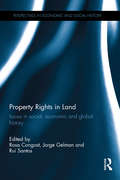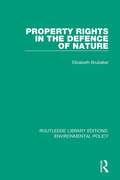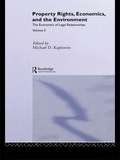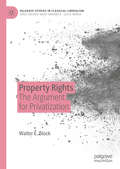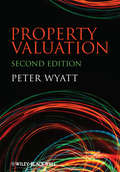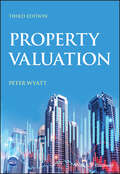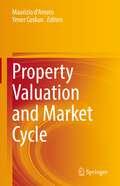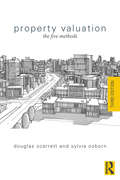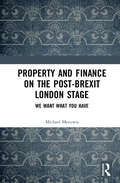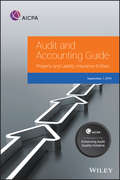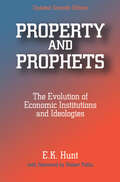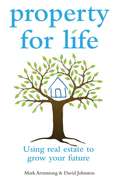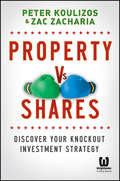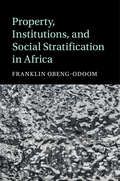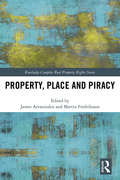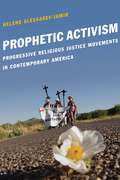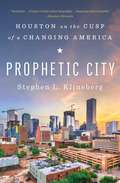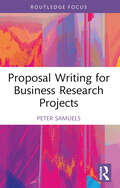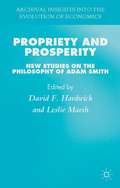- Table View
- List View
Property Rights from Below: Commodification of Land and the Counter-Movement (Routledge Complex Real Property Rights Series)
by Olivier De Schutter Balakrishnan RajagopalRecent years have seen a globalization of property rights as the Western conception of property over land has extended across the world. As formerly community-owned land and natural resources are privatized and titling schemes proliferate, Property Rights from Below questions the trend toward treating land as a commodity and explores alternatives to the Western model. As we enter an era of resource scarcity and as competition for land and associated natural resources increases, purchasing power cannot become the sole criterion for land allocation; and the law of supply and demand in increasingly financialized markets cannot become the sole metric through which the value of land is determined. Using a range of examples from around the world, Property Rights from Below demonstrates that alternatives to this model often emerge from social innovations supported by local communities and that there is an urgent need for a broader political imagination when it comes to land governance. This innovative cross-disciplinary perspective on the pressing problems surrounding global property rights will be of interest to academics, students and professionals with an interest in property law, development economics and land governance.
Property Rights in Land: Issues in social, economic and global history (Perspectives in Economic and Social History #5)
by Rosa Congost, Jorge Gelman and Rui SantosProperty Rights in Land widens our understanding of property rights by looking through the lenses of social history and sociology, discussing mainstream theory of new institutional economics and the derived grand narrative of economic development. As neo-institutional development theory has become a narrative in global history and political economy, the problem of promoting global development has arisen from creating the conditions for ‘good’ institutions to take root in the global economy and in developing societies. Written by a collection of expert authors, the chapters delve into social processes through which property relations became institutionalized and were used in social action for the appropriation of resources and rent. This was in order to gain a better understanding of the social processes intervening between the institutionalized ‘rules of the game’ and their economic and social outcomes. This collection of essays is of great interest to those who study economic history, historical sociology and economic sociology, as well as Agrarian and rural history.
Property Rights in the Defence of Nature (Routledge Library Editions: Environmental Policy #6)
by Elizabeth BrubakerFirst published in 1995. In this study, the author provides a lively and accessible account of the failure of the legal regime to protect the environment. Elizabeth Brubaker explores how legal reliance on property rights has been useful in opposing pollution of land and water. This title will be of interest to students of Environmental Studies, as well as to all those interest in a more secure future for the environment.
Property Rights, Economics and the Environment (The Economics of Legal Relationships)
by Michael D. KaplowitzThis book explores how discussions of environmental policy increasingly require scholars and practitioners to integrate legal-economic analyses of property rights issues. An excellent array of contributors have come together for the first time to produce this magnificent book.
Property Rights: The Argument for Privatization (Palgrave Studies in Classical Liberalism)
by Walter E. BlockIn this timely book, Walter E. Block uses classical liberal theory to defend private property rights. Looking at how free enterprise, capitalism and libertarianism are cornerstones of economically prosperous civilizations, Block highlights why private property rights are crucial. Discussing philosophy, libertarian property rights theory, reparations and other property rights issues, this volume is of interest to academics, students, journalists and all those interested in this integral aspect of political economic philosophy.
Property Tax: An International Comparative Review (Routledge Revivals)
by William McCluskeyFirst published in 1999, this volume aims to add to the existing body of knowledge with regard to application of ad valorem property taxation in various countries. To this end, the present volume has essentially focused on updating, revising and extending the coverage of material included in the earlier book, ‘Comparative Property Tax Systems’. The contributors discuss issues including property tax in Singapore, Ireland, Pakistan, Poland and Cyprus.
Property Valuation
by Peter WyattThis new edition of the 'all in one' textbook for the postgraduate study of valuation on real estate courses retains its focus on the valuation and appraisal of commercial and industrial property across investment, development and occupier markets. It is structured from the client perspective and covers single-asset pricing, risk and return issues.The structure of the book has been substantially revised. Part A introduces the key microeconomic principles, focussing on land as a resource, production functions, supply and demand and price determination. The locational aspect of real estate is also introduced. Macroeconomic considerations are categorised by the main market sectors (and their function); the market for land (development), for space (occupation) and for money (investment). The economic context is set and the author then explains why property valuations are required and discusses the main determinants of value and how they might be identified. The mathematics required to financially quantify value determinants are also introduced. Part B of the book describes the methods of valuation; Part C applies these methods to the valuation of a range of property types for a wide variety of purposes; and Part D covers investment and development appraisal.The author introduces valuation activities from a broad economic perspective, setting valuation in its business finance context and combining its academic and practical roots. Changes in this second edition include:less daunting economicsexpanded companion website with PowerPoint slides for lecturers, self-test Questions & Answers for students: see www.wiley.com/go/wyattpropertyvaluationup-to-date case studies and sample valuationsreference to the newly-published Red Book (the valuer's bible)Property Valuation with its user-friendly format, using tried-and-tested teaching and learning devices and a clear writing style, remains the core text for students on real estate, estate management and land economy degree courses, as well as for fast-track conversion courses for non-cognate graduates.
Property Valuation
by Peter WyattPROPERTY VALUATION The new edition of the popular ‘all-in-one’ textbook on the valuation and appraisal of property, offering a more international perspective on valuation practice Property Valuation provides a comprehensive examination of property valuation principles, methods, issues and applications of the valuation and appraisal of commercial and industrial property across investment, development and occupier markets. With a clear writing style, this easily accessible textbook presents valuation from the client perspective, offering balanced coverage of the theory and practice of single-asset pricing, risk and return issues. The updated third edition reflects significant developments that have occurred in valuation over the past several years, particularly the expanding internationalisation of the valuation profession and the growing interest in valuation practice in emerging economies. Greater emphasis is placed on international content and context, such as the challenges of real estate asset valuation in countries with developing market economies, to offer a more global view of valuation practice. Throughout this edition, chapters link the most recent academic research to practical applications, incorporate the latest professional guidelines and standards and address land and property taxation, compulsory acquisition of land, the valuation of non-market goods and services and key valuation challenges with a more international perspective. Addresses the key challenges faced by valuation professionals in a single, up-to-date volume Combines academic coverage of principles with practical coverage of valuation applications Incorporates consideration of non-market value, including countries where land is seldom sold yet has social and environmental value Contains a wealth of well-developed worked examples and classroom-proven teaching and learning devices Includes access to a companion website with supporting material for students and lecturers Property Valuation, Third Edition is an excellent textbook for advanced undergraduate and graduate courses including real estate finance, real estate economics, property surveying, valuation and land economics in the UK, Europe and North America. It is also a valuable resource for early-career practitioners preparing for professional competency assessments as well as those studying property valuation and appraisal in developing countries and emerging economies.
Property Valuation and Market Cycle
by Maurizio D’Amato Yener CoskunThis book discusses the role of the property market cycle in real estate valuation. Challenging traditional property valuation methods that rely on current market conditions and economic trends, this book argues for a re-evaluation of the relationship between property valuation and cycles in property markets. The book is divided into two parts. The first part gathers research on property market cycle analysis and the delicate problems dealing with property market information including the development of the real estate market index, appraisal bias, and the use of time series in plotting the market cycle. The second part proposes several possible modifications to the traditional income approach methodologies, including cyclical capitalization and the hedonic price method. Furthermore, this part also addresses the need for amendments to current s property valuation standards and institutional regulations. Written by an international cross-section of expert voices in market cycles and property valuation, the book is a comprehensive resource for any researcher or upper-level student studying economic volatility.
Property Valuation: The Five Methods
by Sylvia Osborn Douglas ScarrettThe third edition of Property Valuation: The Five Methods introduces students to the fundamental principles of property valuation theory by means of clear explanation and worked examples. An ideal text for those new to the subject, the book provides 1st year undergraduate students with a working knowledge and understanding of the five methods of valuation and the ways in which they are interlinked.In this fully revised edition, the new author team have: restructured the chapters to ensure a more logical order outlined the economic theory of value and the rules and constraints under which a valuer works provided detailed consideration of each of the five recognised approaches placed a larger emphasis on the Discounted Cash Flow approach These revisions are all written in the concise and accessible style which has made previous editions of the book so successful. The new edition of this textbook will be essential reading for undergraduates on all property, real estate, planning and built environment courses.
Property and Finance on the Post-Brexit London Stage: We Want What You Have
by Michael MeeuwisA guide to the contemporary London stage as well as an argument about its future, the book walks readers through the city’s performance spaces following the Brexit vote. Austerity-era London theatre is suffused with the belief that private ownership defines full citizenship, its perspective narrowing to what an affluent audience might find relatable. From pub theatres to the National, Michael Meeuwis reveals how what gets put on in London interacts with the daily life of the neighbourhoods in which they are set. This study addresses global theatregoers, as well as students and scholars across theatre and performance studies—particularly those interested in UK culture after Brexit, urban geography, class, and theatrical economics.
Property and Liability Insurance Entities 2019 (AICPA Audit and Accounting Guide)
by AICPAStay up−to−date on current GAAP and statutory accounting and audit guidance for property and liability insurance entities. This guide provides a good grounding on the industry, its products and regulatory issues, and the related transaction cycles that a property and liability insurance entity is involved with. Relevant guidance contained in standards issued through September 1, 2019, is covered, including the following: FASB ASU No. 2017−12, Derivatives and Hedging (Topic 815): Targeted Improvements to Accounting for Hedging Activities SSAP No. 26R, Bonds SSAP No. 43R, Loan-backed and Structured Securities SSAP No. 97, Investments in Subsidiary, Controlled and Affiliated Entities Revised for SSAP No. 101, Income Taxes, and NAIC INT 18−03, Additional Elements Under the Tax Cuts and Jobs Act Key topics covered: Understand current GAAP and statutory accounting for property and liability insurance entities. Get authoritative accounting and auditing guidance applicable to property and liability Understand current GAAP and statutory accounting for property and liability insurance entities. Get authoritative accounting and auditing guidance applicable to property and liability insurance entities. Properly develop an audit plan for auditing loss reserves. Easily educate your staff on property and liability insurance.
Property and Political Order in Africa
by Catherine BooneIn sub-Saharan Africa, property relationships around land and access to natural resources vary across localities, districts and farming regions. These differences produce patterned variations in relationships between individuals, communities and the state. This book captures these patterns in an analysis of structure and variation in rural land tenure regimes. In most farming areas, state authority is deeply embedded in land regimes, drawing farmers, ethnic insiders and outsiders, lineages, villages and communities into direct and indirect relationships with political authorities at different levels of the state apparatus. The analysis shows how property institutions - institutions that define political authority and hierarchy around land - shape dynamics of great interest to scholars of politics, including the dynamics of land-related competition and conflict, territorial conflict, patron-client relations, electoral cleavage and mobilization, ethnic politics, rural rebellion, and the localization and 'nationalization' of political competition.
Property and Prophets: The Evolution of Economic Institutions and Ideologies
by E. K. Hunt"Property and Prophets" is a concise history of the rise and subsequent triumph of capitalism. Focused primarily on England until 1800 and the United States since 1800, the book's economic history is interspersed with the history of ideas that evolved along with the capitalist system.
Property for Life: Using Property to Plan Your Financial Future
by Mark Armstrong David JohnstonProperty for Life is an essential guide to the property and finance decisions that Australian homebuyers and investors face throughout the various ages and stages of their lives. Property for Life is the story of Jim and Jane and their property decisions. The book follows them as they buy their first property, have a family, upgrade to a new home, buy an investment property, downsize to a lower maintenance home when their children leave the nest and finally use property as a source of income in their retirement years. As Jim and Jane reach the various property milestones in their lives, the investing principles and general property and financial options available and the pros and cons of these are covered. Issues covered include: saving for a deposit securing a mortgage mortgage insurance researching the market scouting the market negotiating the purchase preparing your home for sale developing an investment strategy reducing debt tax effective investment asset protection maximising cashflow planning for retirement dealing with life changes eg having children, working for yourself Through Jim and Jane's story, Property for Life brings a human dimension to property investing that other books lack. Regardless of whether you are part of a couple, or what age and stage you are at in your life, all readers will be able to identify with Jim and Jane's situation and draw knowledge for their own property investing journey.
Property vs Shares
by Peter Koulizos Zac ZachariaA comparison of property versus shares and how to find the right mix for a profitable portfolioAlmost every investor eventually considers the question: which is the better investment, property or shares? The answer isn't as simple as one or the other, since both asset classes offer different benefits and risks. And if the best answer is a mix of the two, how do you strike the right balance for sustained returns? This book takes an unbiased look at these two asset classes, explaining the risks and benefits of each, dispelling stubborn myths, and giving you the facts you need to find what's best for you and your portfolio. Offering a point-by-point comparison of shares versus property, this easy-to-read guide argues that a combined strategy is smartest and safest for most investors. It then goes on to give you the information you need to tailor your portfolio to your own level of acceptable risk versus desired reward.Offers a simple, in-depth side-by-side comparison of the two most vital asset classes in any portfolioPeter Koulizos is a popular speaker and commentator on property investing and the author of The Property Professor's Top Australian SuburbsZac Zacharia is founder and managing director of financial services company, The Centra Wealth Group, and is a lecturer in share investment, a regular speaker and media contributorIncludes helpful tips on what and when to buy, as well as how to avoid both property and share scamsEvery portfolio should be different, depending on your own individual goals and needs. With this handy guide, you can find the right mix of assets to achieve healthy and consistent returns.
Property, Institutions, and Social Stratification in Africa (Cambridge Studies in Stratification Economics: Economics and Social Identity)
by Franklin Obeng-OdoomIn this book, Franklin Obeng-Odoom seeks to carefully explain, engage, and systematically question the existing explanations of inequalities within Africa and between Africa and the rest of the world using insights from the emerging field of stratification economics. Drawing on multiple sources - including archival and historical material and a wide range of survey data - he develops a distinctive approach that combines key concepts in original institutional economics, such as reasonable value, property, and the distribution of wealth, with other insights into Africa's development and underdevelopment. While looking at the Africa-wide situation, Obeng-Odoom also analyzes the experiences of inequalities within specific countries. Comprehensive and engaging, Property, Institutions, and Social Stratification in Africa is a useful resource for teaching and research on Africa and the Global South.
Property, Place and Piracy (Routledge Complex Real Property Rights Series)
by Martin Fredriksson James ArvanitakisThis book takes the concept of piracy as a starting point to discuss the instability of property as a social construction and how this is spatially situated. Piracy is understood as acts and practices that emerge in zones where the construction and definition of property is ambiguous. Media piracy is a frequently used example where file-sharers and copyright holders argue whether culture and information is a common resource to be freely shared or property to be protected. This book highlights that this is not a dilemma unique to immaterial resources: concepts such as property, ownership and the rights of use are just as diffuse when it comes to spatial resources such as land, water, air or urban space. By structuring the book around this heterogeneous understanding of piracy as an analytical perspective, the editors and contributors advance a trans-disciplinary and multi-theoretical approach to place and property. In doing so, the book moves from theoretical discussions on commons and property to empirical cases concerning access to and appropriation of land, natural and cultural resources. The chapters cover areas such as maritime piracy, the philosophical and legal foundations of property rights, mining and land rights, biopiracy and traditional knowledge, indigenous rights, colonization of space, military expansionism and the enclosure of urban space. This book is essential reading for a variety of disciplines including indigenous studies, cultural studies, geography, political economy, law, environmental studies and all readers concerned with piracy and the ambiguity of property.
Property, Power and the Growth of Towns: Enterprise and Urban Development,1100-1500 (Routledge Explorations in Economic History)
by Mark Casson Catherine CassonLocal enterprise, institutional quality and strategic location were of central importance in the growth of medieval towns. This book, comprising a study of 112 English towns, emphasises these key factors. Downstream locations on major rivers attracted international trade, and thereby stimulated the local processing of imports and exports, while the early establishment of richly endowed religious institutions funnelled agricultural rental income into a town, where it was spent on luxury goods produced by local craftsmen and artisans, and on expensive, long-running building schemes. Local entrepreneurs who recognised the economic potential of a town developed residential suburbs which attracted wealthy residents. Meanwhile town authorities invested in the building and maintenance of bridges, gates, walls and ditches, often with financial support from wealthy residents. Royal lordship was also an advantage to a town, as it gave the town authorities direct access to the king and bypassed local power-brokers such as bishops and earls. The legacy of medieval investment remains visible today in the streets of important towns. Drawing on rentals, deeds and surveys, this book also examines in detail the topography of seven key medieval towns: Bristol, Gloucester, Coventry, Cambridge, Birmingham, Shrewsbury and Hull. In each case, surviving records identify the location and value of urban properties, and their owners and tenants. Using statistical techniques, previously applied only to the early modern and modern periods, the book analyses the impact of location and type of property on property values. It shows that features of the modern property market, including spatial autocorrelation, were present in the middle ages. Property hot-spots of high rents are also identified; the most valuable properties were those situated between the market and other focal points such transport hubs and religious centres, convenient for both, but remote from noise and pollution. This book takes an interdisciplinary approach, drawing on expertise from the disciplines of economics and history. It will be of interest to historians and to social scientists looking for a long-run perspective on urban development.
Property, Predation, and Protection
by Stanislav MarkusWhat threatens the property rights of business owners - and what makes these rights secure? This book transcends the conventional diagnosis of the issue in modern developing countries by moving beyond expropriation by the state ruler or by petty bureaucratic corruption. It identifies "agent predation" as a novel threat type, showing it to be particularly widespread and detrimental. The book also questions the orthodox prescription: institutionalized state commitment cannot secure property rights against agent predation. Instead, this volume argues that business actors can hold the predatory state agents accountable through firm-level alliances with foreign actors, labor, and local communities. Beyond securing ownership, such alliances promote rule of law in a rent-seeking society. Taking Russia and Ukraine between 2000 and 2012 as its empirical focus, the book advances these arguments by drawing on more than 150 qualitative interviews with business owners, policy makers, and bureaucrats, as well as an original large-N survey of firms.
Prophetic Activism: Progressive Religious Justice Movements in Contemporary America (Religion and Social Transformation #2)
by Helene Slessarev-JamirWhile the links between conservative Christians and politics have been drawn strongly in recent years, coming to embody what many think of as religious activism, the profoundly religious nature of community organizing and other more left-leaning justice work has been largely overlooked. Prophetic Activism is the first broad comparative examination of progressive religious activism in the United States. Set up as a counter-narrative to religious conservatism, the book offers readers a deeper understanding of the richness and diversity of contemporary religious activism.Helene Slessarev-Jamir offers five case studies of major progressive religious justice movements that have their roots in liberative interpretations of Scripture: congregational community organizing; worker justice; immigrant rights work; peace-making and reconciliation; and global anti-poverty and debt relief. Drawing on intensive interviews with activists at all levels of this work—from pastors and congregational leaders to local organizers and the executive directors of the national networks—she uncovers the ways in which they construct an ethical framework for their work. In addition to looking at predominantly Christian organizations, the book also highlights the growth of progressive activism among Jews, Muslims, and Buddhists who are engaged in reinterpreting their religious texts to support new forms of activism. Religion and Social Transformation series
Prophetic City: Houston on the Cusp of a Changing America
by Stephen L. KlinebergSociologist Stephen Klineberg presents fascinating and groundbreaking research that shows how the city of Houston has emerged as a microcosm for America&’s future—based on an unprecedented thirty-eight-year study of its changing economic, demographic, and cultural landscapes.Houston, Texas, long thought of as a traditionally blue-collar black/white southern city, has transformed into one of the most ethnically and culturally diverse metro areas in the nation, surpassing even New York by some measures. With a diversifying economy and large numbers of both highly-skilled technical jobs in engineering and medicine and low-skilled minimum-wage jobs in construction, restaurant work, and personal services, Houston has become a magnet for the new divergent streams of immigration that are transforming America in the 21st century. And thanks to an annual systematic survey conducted over the past thirty-eight years, the ongoing changes in attitudes, beliefs, and life experiences have been measured and studied, creating a compelling data-driven map of the challenges and opportunities that are facing Houston and the rest of the country. In Prophetic City, we&’ll meet some of the new Americans, including a family who moved to Houston from Mexico in the early 1980s and is still trying to find work that pays more than poverty wages. There&’s a young man born to highly-educated Indian parents in an affluent Houston suburb who grows up to become a doctor in the world&’s largest medical complex, as well as a white man who struggles with being prematurely pushed out of the workforce when his company downsizes. This timely and groundbreaking book tracks the progress of an American city like never before. Houston is at the center of the rapid changes that have redefined the nature of American society itself in the new century. Houston is where, for better or worse, we can see the American future emerging.
Proposal Writing for Business Research Projects (Routledge Focus on Business and Management)
by Peter SamuelsThis book helps students with the initial phases of their business research project, offering a clear step-by-step approach from defining aims and research questions through to conducting literature reviews and writing a methodology. Features to aid learning include chapter objectives, plentiful real-life examples to demonstrate good practice, exercises to apply the concepts and further reading for proactive investigation. A self-contained guide to every stage of writing an effective business research proposal, this text should be recommended reading for all advanced undergraduate and postgraduate students studying Business Research Methods and embarking on a research project of their own.
Proposing to Redesign a Global Investment Bank
by David G. FubiniA major, NYC-based, global investment bank is looking to rethink its Systems strategy amid a rapidly evolving digital landscape. Your firm has served the client across most of its major geographies on a range of substantial Systems and IT efforts, but is facing competition from two other leading firms who have also supported the client. As you work to develop a proposal, your firm must balance voices from a number of Senior Partners, each of whom has supported the client and has a unique perspective, incorporate the right specialists with technical expertise, and chart a way forward. How should your firm organize to win the work?
Propriety and Prosperity
by Leslie Marsh David F. HardwickThis book is a collection of specially commissioned chapters from philosophers, economists, and political scientists, focusing on Adam Smith's two main works Theory of Moral Sentiments and Wealth of Nations with a view to bringing Smith to a mainstream philosophy audience while simultaneously informing Smith's traditional constituency.
